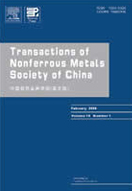Parameters affecting microsegregation in phase-field simulation
(1. CAD Center, Lanzhou University of Technology, Lanzhou 730050, China;
2. State Key Laboratory of Gansu New Non-Ferrous Metal Materials, Lanzhou 730050, China;
3. Department of Mechanical Engineering, Tsinghua University, Beijing 10084, China)
2. State Key Laboratory of Gansu New Non-Ferrous Metal Materials, Lanzhou 730050, China;
3. Department of Mechanical Engineering, Tsinghua University, Beijing 10084, China)
Abstract: The influence of various material and computational parameters such as interface kinetic coefficient(β), surface energy(σ), anisotropy parameter(γ) and the noise amplitude(α) upon microsegregation patterns during the crystal growth was investigated by using the phase-field model which incorporated the concentration field equations. The computed results indicate that, when the appropriate value is assigned to α, the fluctuant scope of solute composition in the solid is steady, and the influence of α on microsegregation is small; the larger the interface kinetic coefficient β, the more acutely the solute composition in the solid fluctuates, but the severity of microsegregation in the front interface reduces; with the increment of anisotropy parameter γ, the fluctuation of solute composition in the solid becomes more acutely, and the severity of microsegregation in the front interface aggravates; the larger surface energy σ, the smaller the fluctuant scope of solute composition in the solid is, and the smaller the degree of microsegregation is.
Key words: microsegregation; phase-field approach; microstructure; numerical simulation

